Effects of Pre-Deformation in Corrosion Fatigue Crack Growth of Al-Mg-Zn Alloy
Abstract
:1. Introduction
2. Materials and Methods
2.1. Materials and Mechanical Properties
2.2. Microstructure
2.3. Molecular Dynamics Simulation
2.4. Corrosion Fatigue Crack Propagation
3. Results and Discussion
3.1. Microstructure and Mechanical Properties
3.2. Molecular Dynamics Calculation Results
3.3. Corrosion Fatigue Crack Growth Rate Curve
3.4. Corrosion Fatigue Crack Propagation Path
3.5. Fractography
3.6. Mechanism Analysis
4. Conclusions
- Enhanced Tensile Strength: The results show that pre-deformation improves the tensile strength of Al-Mg-Zn alloy, with increases of 2.63% and 10.00% at 5% and 10% pre-deformation, respectively, compared to the unstrained condition.
- Influence on Crack Propagation: Corrosion fatigue crack propagation is significantly affected by pre-deformation, with thresholds varying as L2 (6.36 MPa·m1/2) > L0 (6.05 MPa·m1/2) > L1 (5.13 MPa·m1/2). Higher dislocation densities at 10% pre-deformation enhance resistance to crack propagation.
- Molecular dynamics simulations showed that as the pre-deformation level increased, the dislocation density also increased, consistent with the results of the tensile tests. However, the uneven distribution of dislocations also led to stress concentration, which to some extent promoted the propagation of corrosion fatigue cracks.
Author Contributions
Funding
Institutional Review Board Statement
Informed Consent Statement
Data Availability Statement
Conflicts of Interest
References
- Chen, L.; Yuan, S.; Kong, D.; Zhao, G.; Zhang, C. Influence of aging treatment on the microstructure, mechanical properties and anisotropy of hot extruded Al-Mg-Si plate. Mater. Des. 2019, 182, 107999. [Google Scholar] [CrossRef]
- Liu, X.S.; Zhang, L.; Wang, L.S.; Wu, S.H.; Fang, H.Y. Fatigue behavior and life prediction of A7N01 aluminium alloy welded joint. Trans. Nonferrous Met. Soc. China 2012, 22, 2930–2936. [Google Scholar] [CrossRef]
- Ana, J.; Chena, J.; Goua, G.; Qina, C.; Chena, H.; Lic, P.; Lid, Z. Research on Corrosion Fatigue Crack Propagation Behavior of Welded Joints of A7N01P-T4 Aluminum Alloys. J. Corros. Sci. Eng. 2016, 19, 1–14. [Google Scholar]
- Peng, Y.; Li, D.; Wu, H.; Miao, K.; Liu, C.; Wang, L.; Liu, W.; Xu, C.; Geng, L.; Wu, P.; et al. Insights into the deformation mechanisms of an Al1Mg0.4Si alloy at cryogenic temperature: An integration of experiments and crystal plasticity modeling. J. Mater. Sci. Technol. 2024, 200, 69–82. [Google Scholar] [CrossRef]
- Jalali, M.; Jafarian, H.R.; Shanaghi, A.; Eivani, A.R. On the microstructure and corrosion behavior of Fe-28.5Ni steel subjected to severe plastic deformation. J. Mater. Res. Technol. 2025, 34, 90–99. [Google Scholar] [CrossRef]
- Meng, L.; Zhao, Z.; Lin, P.; Jiang, Z.; Zhao, J. Achieving enhanced strength-ductility synergy in heterogeneous equiaxed structured Ti-6Al-4V alloy sheets by cryogenic pre-stretching. Mater. Des. 2025, 249, 113563. [Google Scholar] [CrossRef]
- Cavalcante, T.R.F.; Pereira, G.S.; Koga, G.Y.; Bolfarini, C.; Filho, W.W.B.; Avila, J.A. Fatigue crack propagation of aeronautic AA7050-T7451 and AA2050-T84 aluminum alloys in air and saline environments. Int. J. Fatigue 2022, 154, 106519. [Google Scholar] [CrossRef]
- Young, G.A.; Scully, J.R. The effects of test temperature, temper, and alloyed copper on the hydrogen-controlled crack growth rate of an Al-Zn-Mg-(Cu) alloy. Metall. Mater. Trans. A 2002, 33, 101–115. [Google Scholar] [CrossRef]
- Horner, D.A.; Connolly, B.J.; Zhou, S.; Crocker, L.; Turnbull, A. Novel images of the evolution of stress corrosion cracks from corrosion pits. Corros. Sci. 2011, 53, 3466–3485. [Google Scholar] [CrossRef]
- Holroyd, N.; Scamans, G.M. Crack Propagation During Sustained-Load Cracking of Al-Zn-Mg-Cu Aluminum Alloys Exposed to Moist Air or Distilled Water. Metall. Mater. Trans. A 2011, 42, 3979–3998. [Google Scholar] [CrossRef]
- Thirumalaikumarasamy, D.; Shanmugam, K.; Balasubramanian, V. Influence of chloride ion concentration on immersion corrosion behaviour of plasma sprayed alumina coatings on AZ31B magnesium alloy. J. Magnes. Alloys 2014, 2, 325–334. [Google Scholar] [CrossRef]
- Qi, X.; Song, R.; Qi, W.; Jin, J.; Wang, C.; Li, H.; Sun, B. Correspondence between Susceptibility to SCC of 7050 Aluminum Alloy and Passive Film-induced Stress at Various pH Values. J. Cent. South Univ. 2017, 32, 173–178. [Google Scholar] [CrossRef]
- Shah, S.R.; Pryce, I.L.; John, T.S.; Greer, J.M. Effect of Environmental Corrosion on Fatigue Crack Growth Morphology: A Detailed Investigation of the Boundary between Fatigue and Corrosion Control Regimes. Adv. Mater. Res. 2014, 891, 278–285. [Google Scholar] [CrossRef]
- Borchers, T.E.; McAllister, D.P.; Zhang, W. Macroscopic segregation and stress corrosion cracking in 7xxx series aluminum alloy arc welds. Metall. Mater. Trans. A 2015, 46, 1827–1833. [Google Scholar] [CrossRef]
- Ma, A.; Roters, F.; Raabe, D. A dislocation density based constitutive law for BCC materials in crystal plasticity FEM. Comp. Mater. Sci. 2007, 39, 91–95. [Google Scholar] [CrossRef]
- Jung, S.; Kwon, Y.; Lee, C.S.; Lee, B. Influence of hydrogen on the grain boundary crack propagation in bcc iron: A molecular dynamics simulation. Comp. Mater. Sci. 2018, 149, 424–434. [Google Scholar] [CrossRef]
- Terentyev, D.; Zhurkin, E.E.; Bonny, G. Emission of full and partial dislocations from a crack in BCC and FCC metals: An atomistic study. Comp. Mater. Sci. 2012, 55, 313–321. [Google Scholar] [CrossRef]
- Baskes, M.I. Modified embedded-atom potentials for cubic materials and impurities. Phys. Rev. B 1992, 46, 2727. [Google Scholar] [CrossRef]
- Feng, Q.; Song, X.; Xie, H.; Wang, H.; Liu, X.; Yin, F. Deformation and plastic coordination in WC-Co composite—Molecular dynamics simulation of nanoindentation. Mater. Des. 2017, 120, 193–203. [Google Scholar] [CrossRef]
- GB/T 12160-2002; Calibration of Extensometers for Uniaxial Tests, National Standard of China. Standardization Administration of China: Beijing, China, 2002.
- GB/T 20120.2-2006; Corrosion of Metals and Alloys—Corrosion Fatigue Test—Part 2: Crack Propagation Test on Pre-Cracked Specimens, National Standard of China. Standardization Administration of China: Beijing, China, 2006.
- GB/T 6398-2017; Metallic Materials-Fatigue Test-Fatigue Crack Growth Method, National Standard of China. Standardization Administration of China: Beijing, China, 2017.
- Lu, D.; Lin, B.; Liu, T.; Deng, S.; Guo, Y.; Li, J.; Liu, D. Effect of grain structure on fatigue crack propagation behavior of Al-Cu-Li alloys. J. Mater. Sci. Technol. 2023, 148, 75–89. [Google Scholar] [CrossRef]
- Tian, N.; Feng, Z.; Shi, X.; Wang, W.; Liu, K.; Zhao, G.; Qin, G. Effects of Pre-Tensile Deformation on the Fatigue Fracture Behavior of Annealed 7005 Aluminum Alloy Plate. Materials 2022, 15, 623. [Google Scholar] [CrossRef] [PubMed]
- Yakovtseva, O.; Sitkina, M.; Mosleh, A.O.; Mikhaylovskaya, A. High Strain Rate Superplasticity in Al-Zn-Mg-Based Alloy: Microstructural Design, Deformation Behavior, and Modeling. Materials 2020, 13, 2098. [Google Scholar] [CrossRef] [PubMed]
- Cheng, X.; Furukawa, M.; Horita, Z.; Langdon, T.G. Producing Superplastic Ultrafine-Grained Aluminum Alloys through Severe Plastic Deformation. In Materials Science Forum; Trans Tech Publications Ltd.: St. Margrethen, Switzerland, 2004; pp. 403–410. [Google Scholar]
- Wang, Y.; Li, Y.; Yu, W.; Tang, H.; Wang, H.; Xu, G.; Wang, Z. Effect of a special thermo-mechanical treatment process on microstructure and properties of 7185 alloy. J. Alloys Compd. 2023, 935, 168072. [Google Scholar] [CrossRef]
- Ramesh, S.; Anne, G.; Naik, G.M.; Jagadeesh, C.; Nayaka, H.S. Microstructural and mechanical characterisation of Al-Zn-Mg-Cu alloy processed by multi-directional cryo-forging. Mater. Today Proc. 2021, 46, 5752–5756. [Google Scholar] [CrossRef]
- Liu, X.; You, X.; Liu, Z.; Nie, J.; Zhuang, Z. Molecular dynamical investigation on plastic behavior of Cu(100) twist-grain boundary under uniaxial tension. Acta Phys. Sin. 2009, 58, 1849–1856. [Google Scholar]
- Ouyang, D.; Mao, R.; Zhang, L.; Liang, S.; Song, J. Study on the tensile properties of Al-Zn-Mg alloy based on molecular dynamics. Eng. Fail. Anal. 2024, 155, 107752. [Google Scholar] [CrossRef]
- Yu, C.; Feng, Y.; Wang, L.; Fu, J.; Kang, F.; Zhao, S.; Guo, E.; Ma, B. Effect of pre-stretching deformation treatment process on microstructure and mechanical properties of Al-Cu-Mg alloy. Mater. Today Commun. 2022, 31, 103368. [Google Scholar] [CrossRef]
- Briffod, F.; Bleuset, A.; Shiraiwa, T.; Enoki, M. Effect of crystallographic orientation and geometrical compatibility on fatigue crack initiation and propagation in rolled Ti-6Al-4V alloy. Acta Mater. 2019, 177, 56–67. [Google Scholar] [CrossRef]
- Wang, W.; Wu, H.; Sun, Y.; Yan, J.; Zhang, L.; Zhang, S.; Ni, J.; Song, Y.; Zhang, X. Local intragranular misorientation accelerates corrosion in biodegradable Mg. Acta Biomater. 2020, 101, 575–585. [Google Scholar] [CrossRef]
- Safyari, M.; Khossossi, N.; Meisel, T.; Dey, P.; Prohaska, T.; Moshtaghi, M. New insights into hydrogen trapping and embrittlement in high strength aluminum alloys. Corros. Sci. 2023, 223, 111453. [Google Scholar] [CrossRef]
- Xiang, S.; Mo, W.; Ouyang, Z.; Deng, P.; Tan, H.; Luo, B.; Bai, Z. Effects of pre-deformation on microstructure, mechanical properties and corrosion performance of an Al-Cu-Mg-Ag alloys. J. Alloys Compd. 2024, 987, 174222. [Google Scholar] [CrossRef]
- Chen, Y.Q.; Zhang, H.; Pan, S.P.; Song, Y.F.; Liu, X.; Liu, W.H. Effects of service environment and pre-deformation on the fatigue behaviour of 2524 aluminium alloy. Arch. Civ. Mech. Eng. 2019, 20, 5. [Google Scholar] [CrossRef]
- Mikhaylovskaya, A.V.; Yakovtseva, O.A.; Sitkina, M.N.; Kotov, A.D. Grain-boundary and intragranular deformation in ultrafine-grained aluminum-based alloy at high strain rate. Mater. Lett. 2020, 276, 128242. [Google Scholar] [CrossRef]
- Berecz, T.; Jenei, P.; Csóré, A.; Lábár, J.; Gubicza, J.; Szabó, P.J. Determination of dislocation density by electron backscatter diffraction and X-ray line profile analysis in ferrous lath martensite. Mater. Charact. 2016, 113, 117–124. [Google Scholar] [CrossRef]
- Shengyu, W.; Zhu, X.; Zheng, W.; Zhou, L.I.; Ziqian, Z. Microstructure and tensile properties of industrially prepared 7050 aluminum alloy thick plate. Nonferrous Met. Sci. Eng. 2017, 8, 48–53. [Google Scholar]
- Chen, Y.J.; Yang, Y.B.; Zhang, Z.M.; Wang, Q. Hot torsional deformation behavior of 7A04 aluminum alloy, Suxing Gongcheng Xuebao. J. Plast. Eng. 2018, 25, 167–174. [Google Scholar]
- Yang, Q.; Deng, Z.; Zhang, Z.; Liu, Q.; Jia, Z.; Huang, G. Effects of strain rate on flow stress behavior and dynamic recrystallization mechanism of Al-Zn-Mg-Cu aluminum alloy during hot deformation. Mater. Sci. Eng. A 2016, 662, 204–213. [Google Scholar] [CrossRef]
- Hu, J.L.; Wu, X.J.; Bo, H.; Jiao, Z.T.; Huang, S.Q.; Jin, M. Dislocation density model and microstructure of 7A85 aluminum alloy during thermal deformation. J. Cent. South. Univ. 2021, 28, 2999–3007. [Google Scholar] [CrossRef]
- Chen, S.; Chen, K.; Peng, G.; Chen, X.; Ceng, Q. Effect of heat treatment on hot deformation behavior and microstructure evolution of 7085 aluminum alloy. J. Alloys Compd. 2012, 537, 338–345. [Google Scholar] [CrossRef]
- Hallberg, H.; Chamanfar, A.; Nanninga, N.E. A constitutive model for the flow stress behavior and microstructure evolution in aluminum alloys under hot working conditions—With application to AA6099. Appl. Math. Model. 2020, 81, 253–262. [Google Scholar] [CrossRef]
- Wu, H.; Wen, S.P.; Huang, H.; Wu, X.L.; Gao, K.Y.; Wang, W.; Nie, Z.R. Hot deformation behavior and constitutive equation of a new type Al–Zn–Mg–Er–Zr alloy during isothermal compression. Mater. Sci. Eng. A 2016, 651, 415–424. [Google Scholar] [CrossRef]
- Schwarzenböck, E.; Ollivier, E.; Garner, A.; Cassell, A.; Hack, T.; Barrett, Z.; Engel, C.; Burnett, T.L.; Holroyd, N.H.; Robson, J.D. Environmental cracking performance of new generation thick plate 7000-T7x series alloys in humid air. Corros. Sci. 2020, 171, 108701. [Google Scholar] [CrossRef]
- Hornbogen, E.; Gahr, K. Microstructure and Fatigue Crack Growth in a γ-Fe-Ni-Al Alloy. Acta Metall. 1976, 24, 581–592. [Google Scholar] [CrossRef]
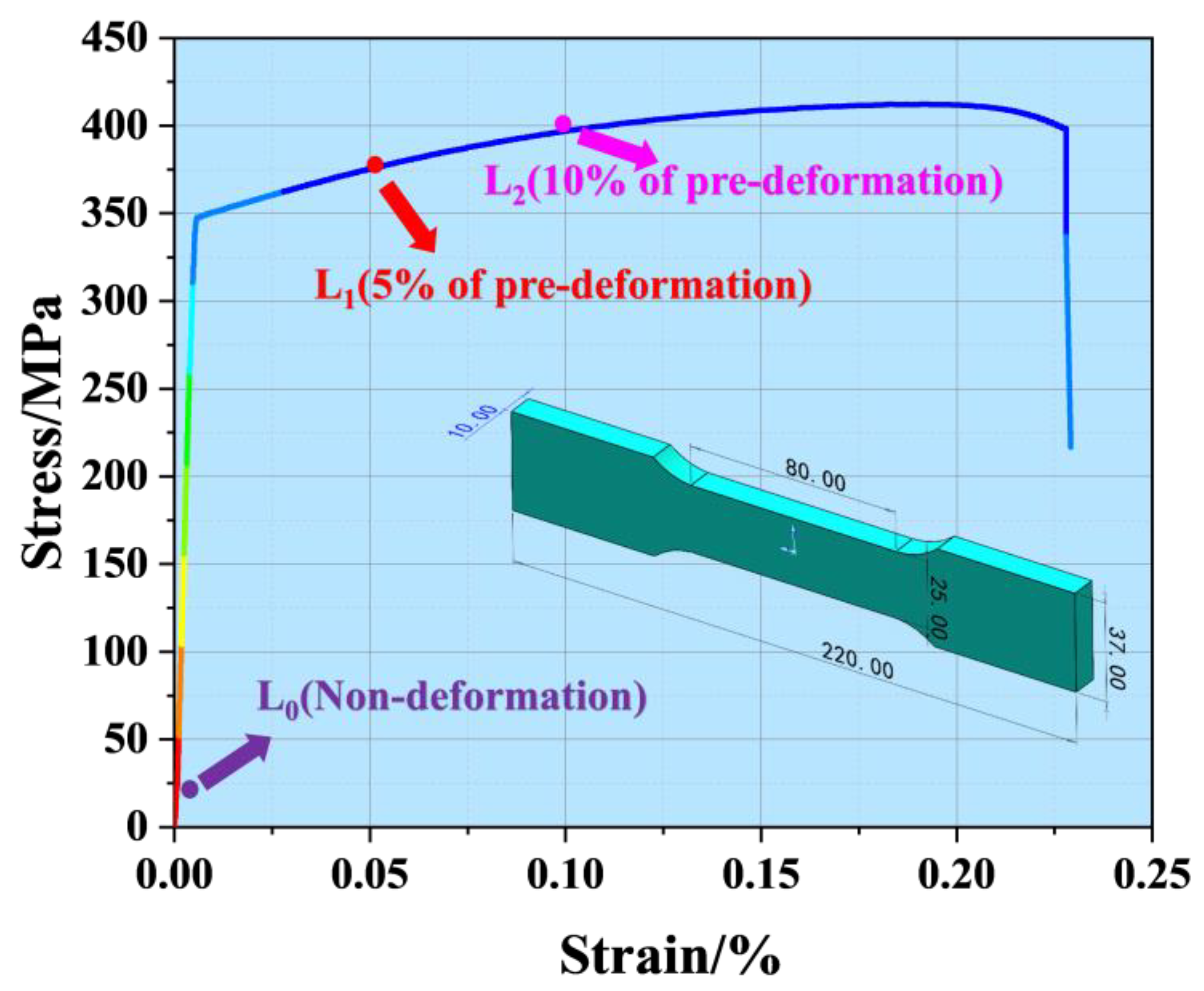
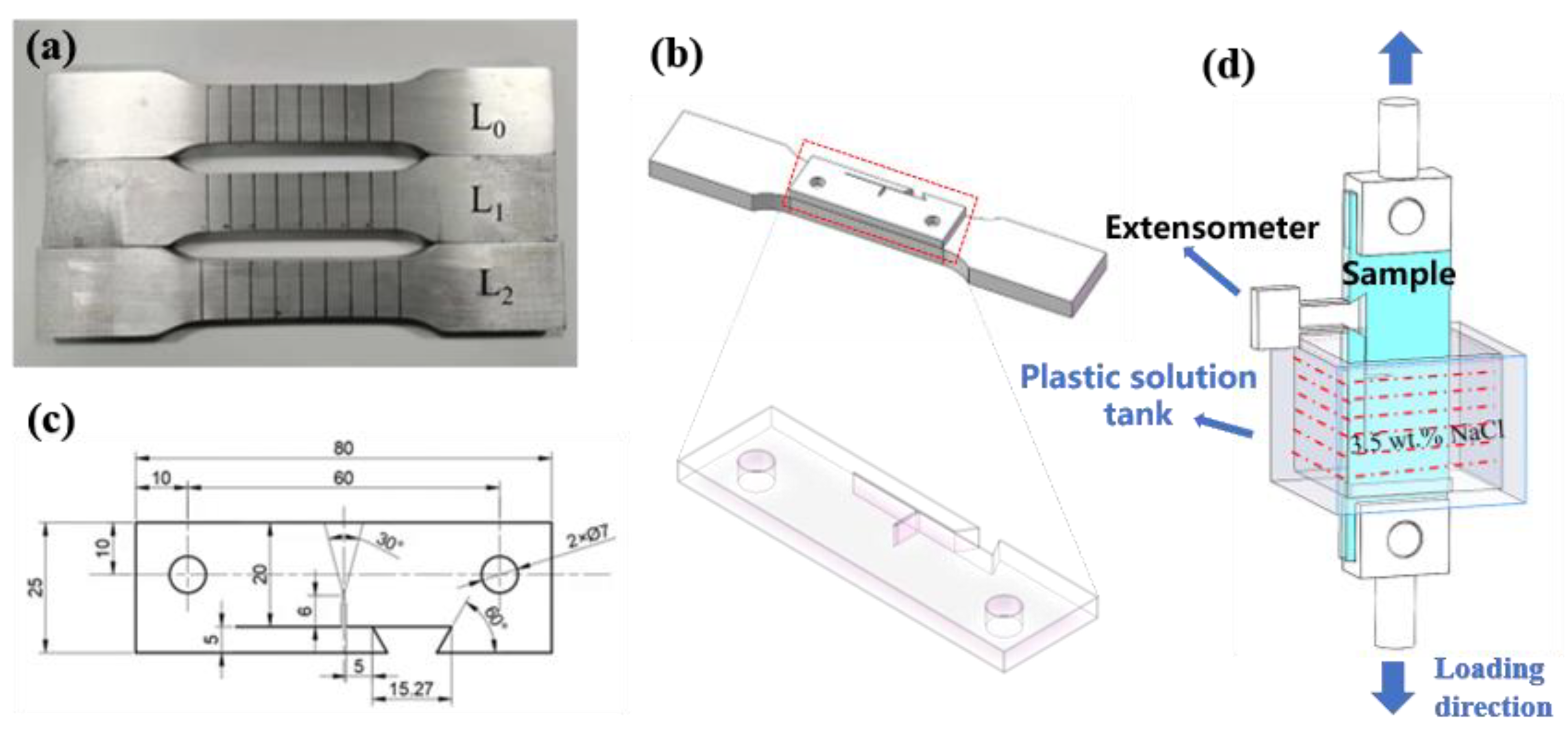
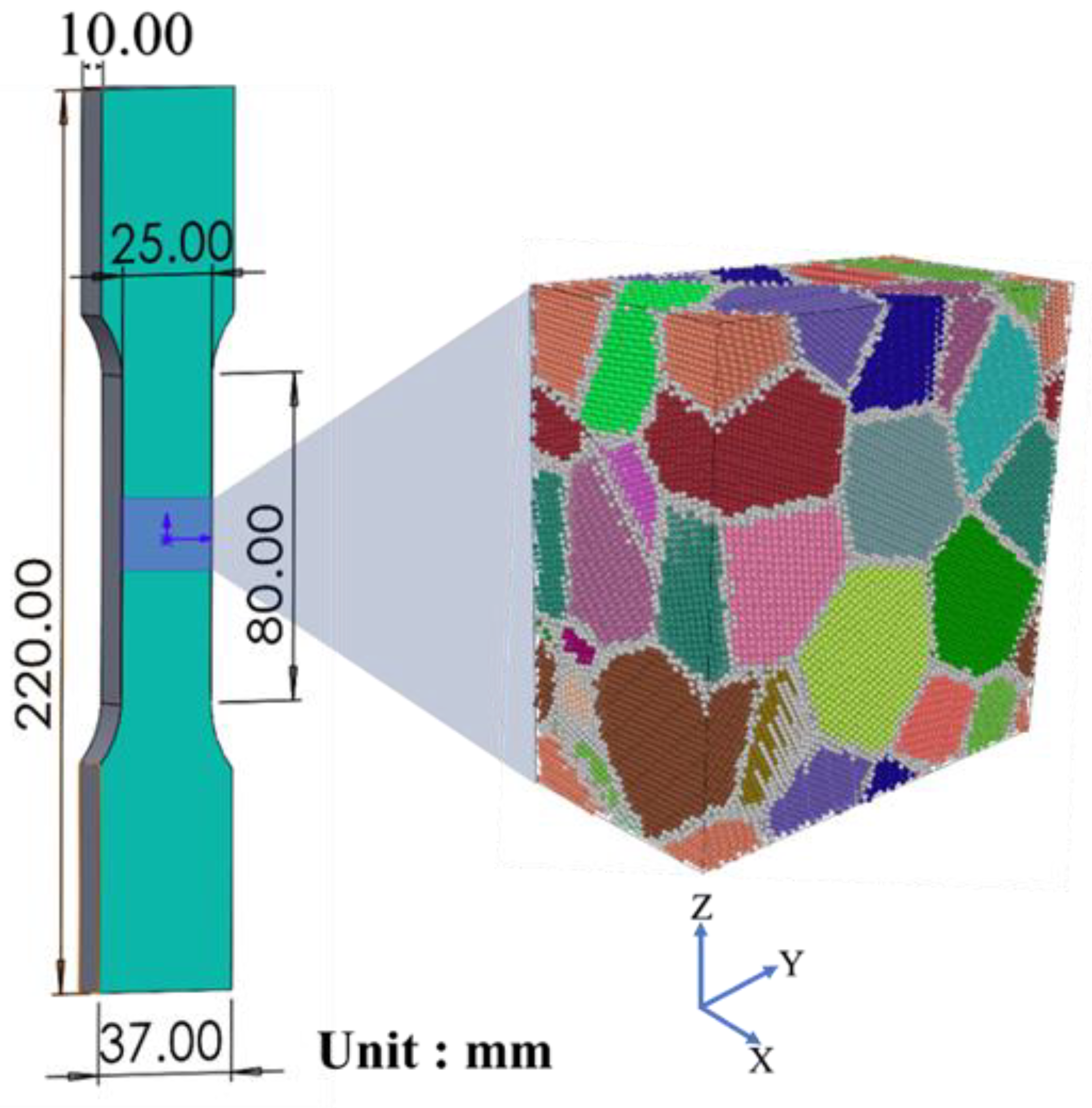
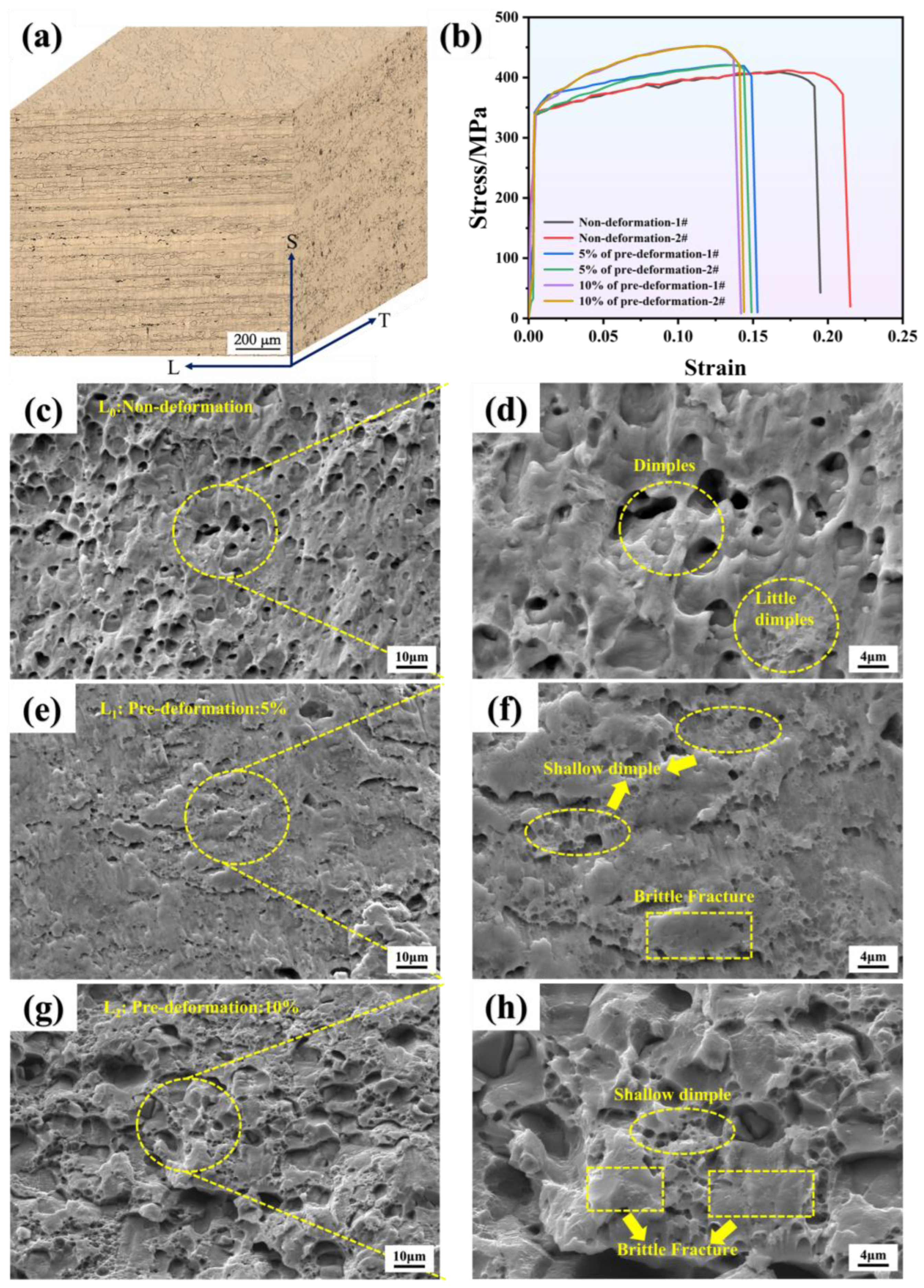
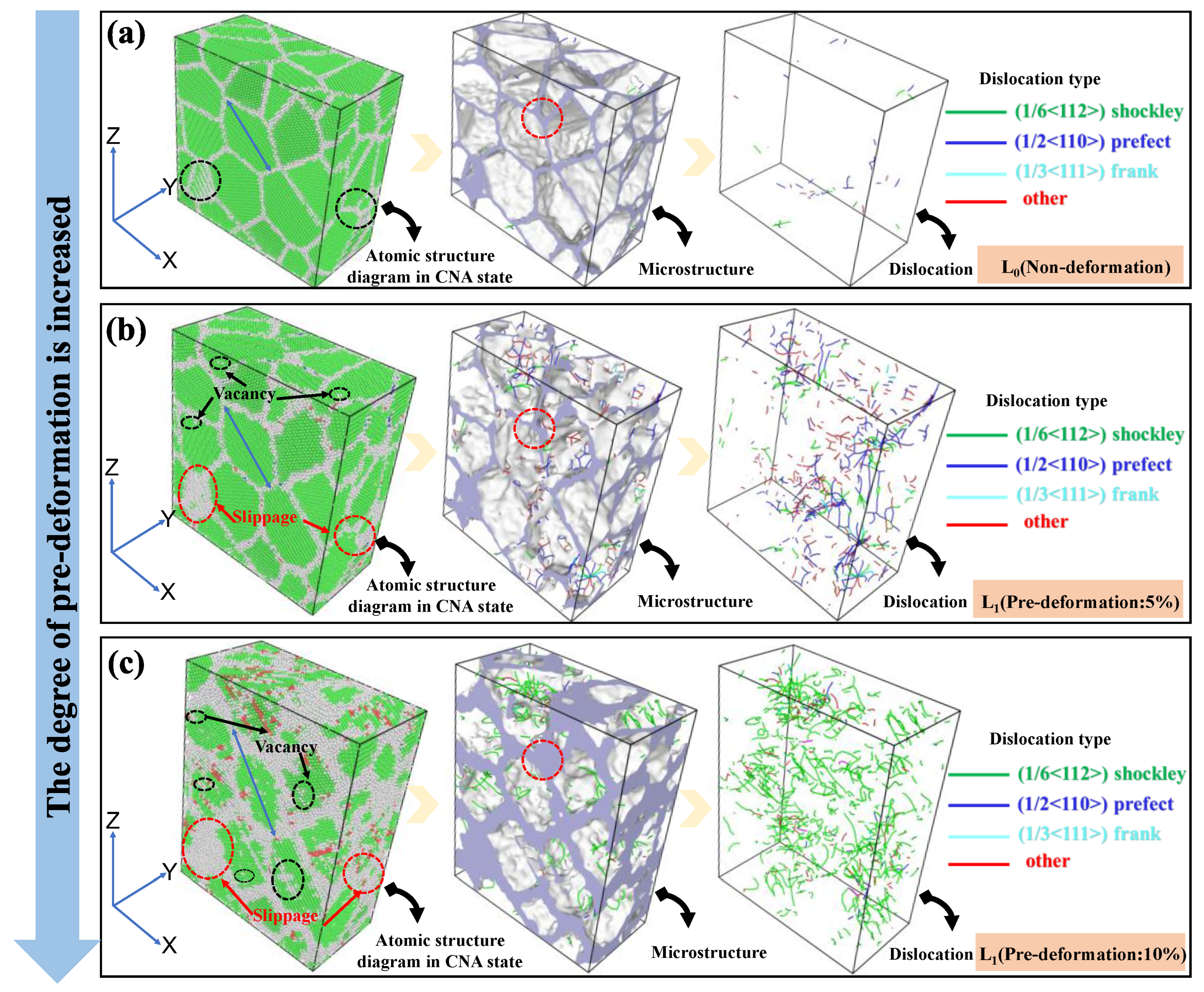
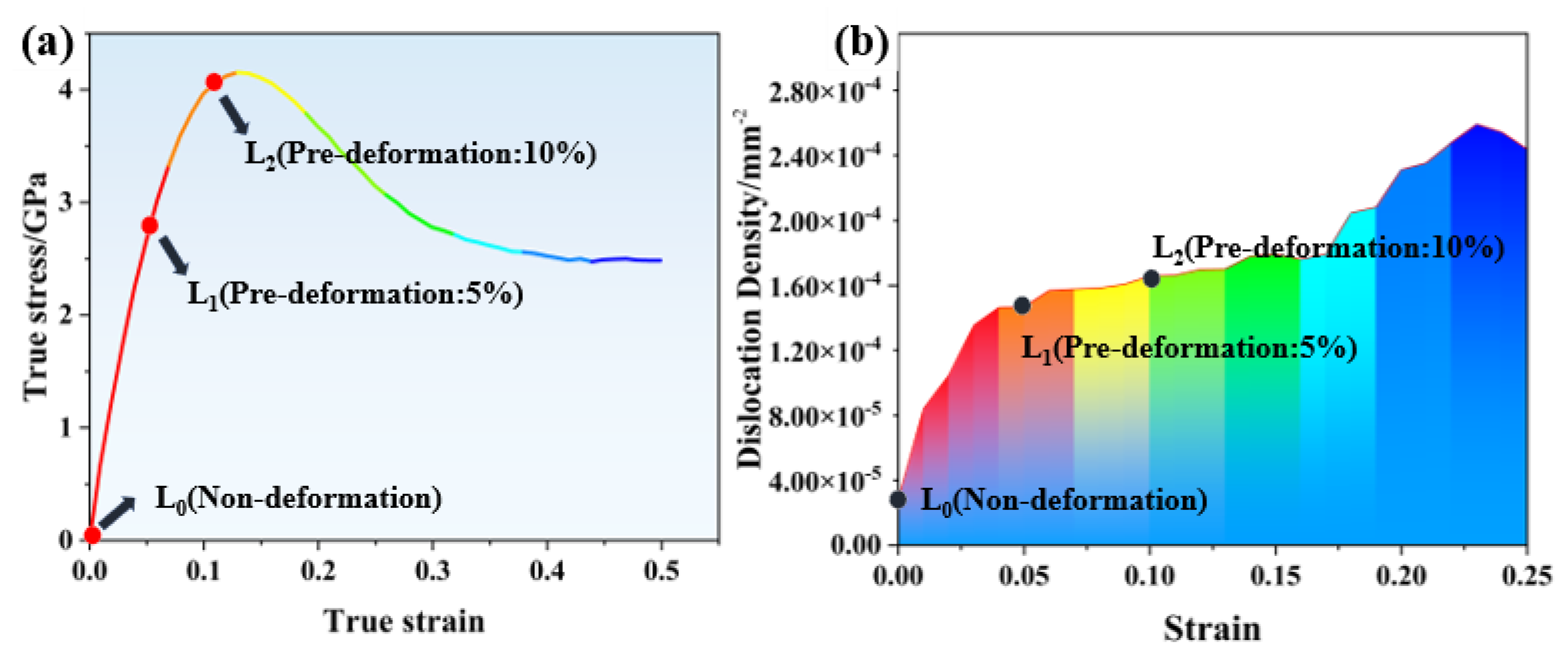
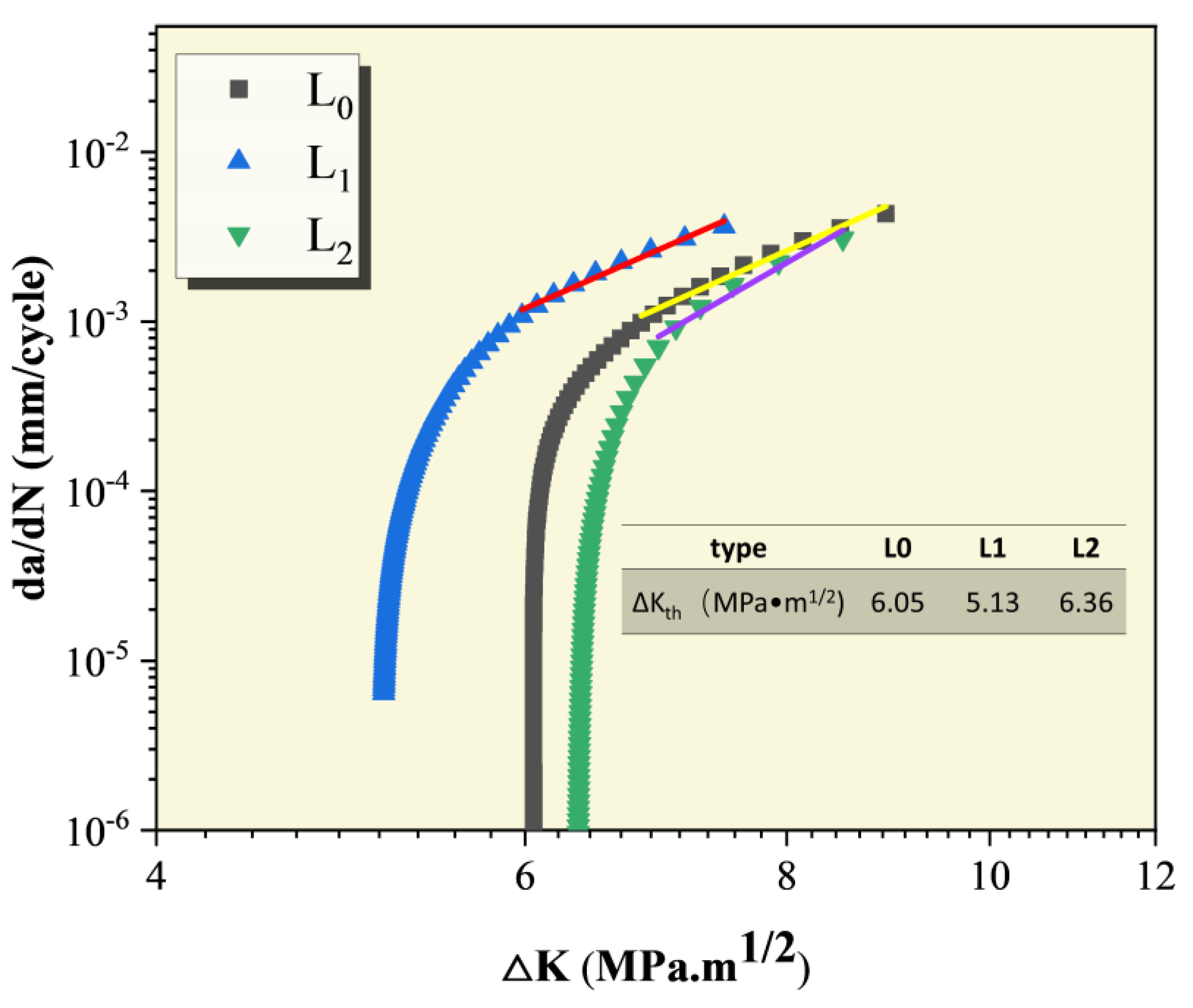
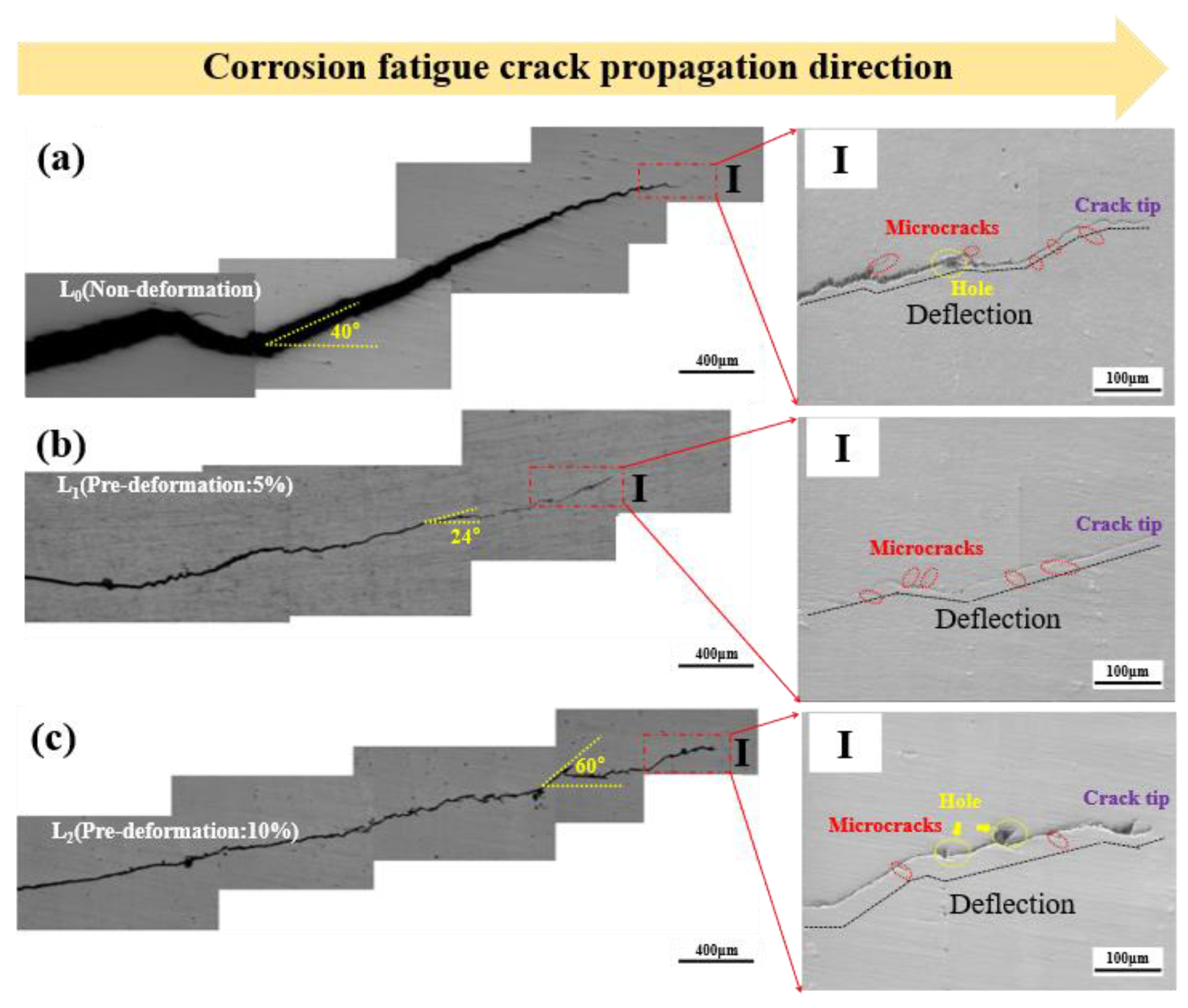
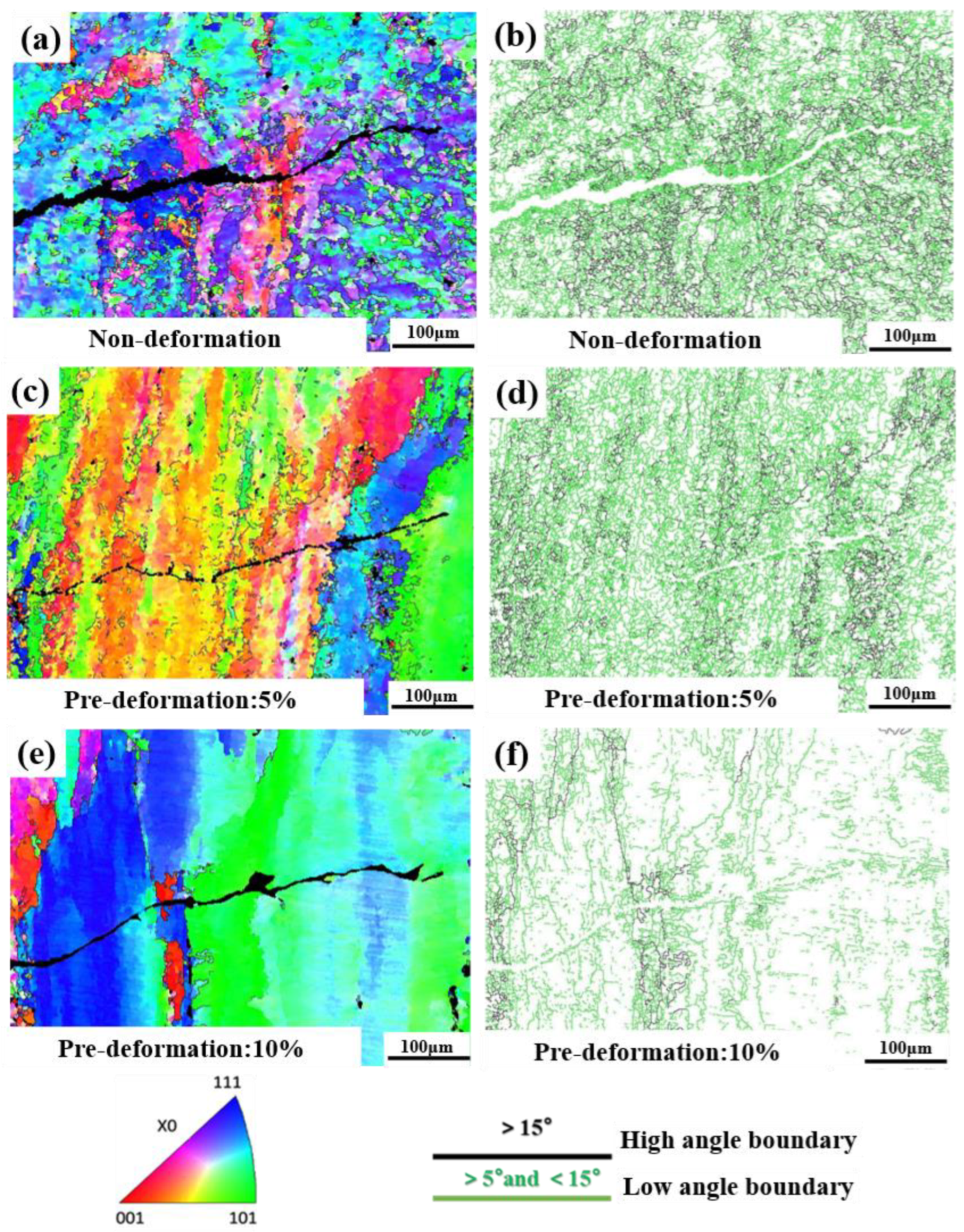
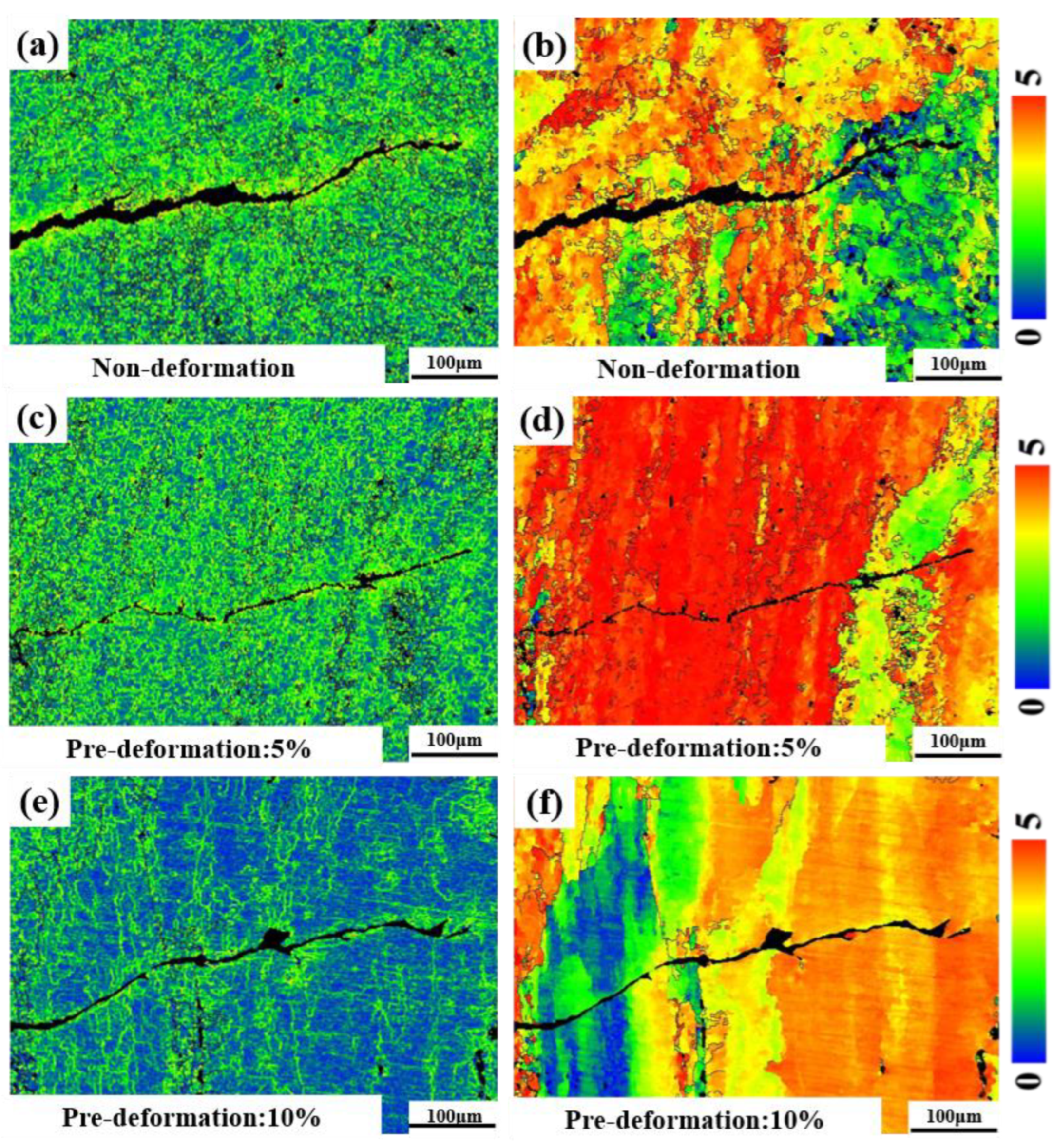

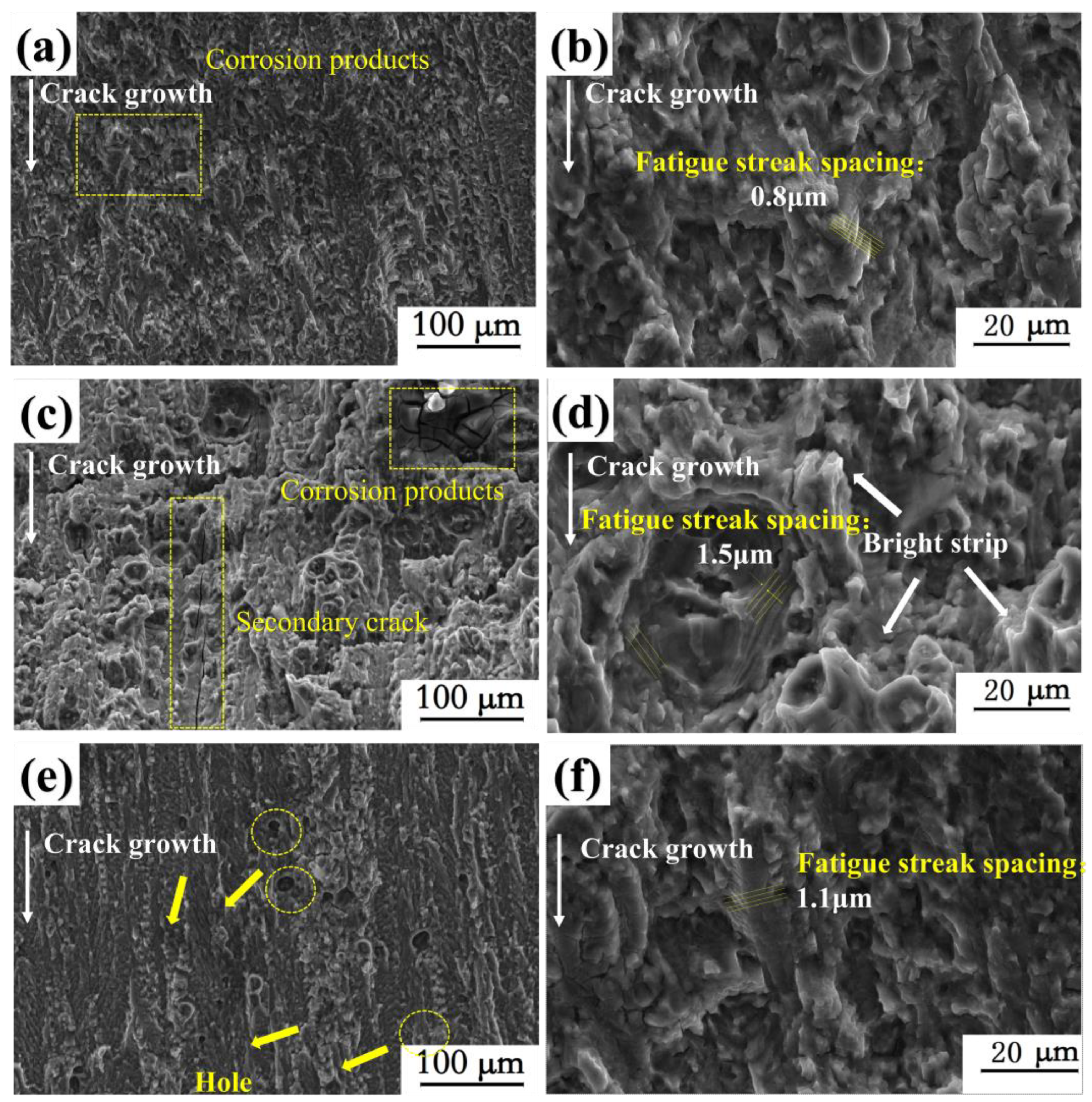
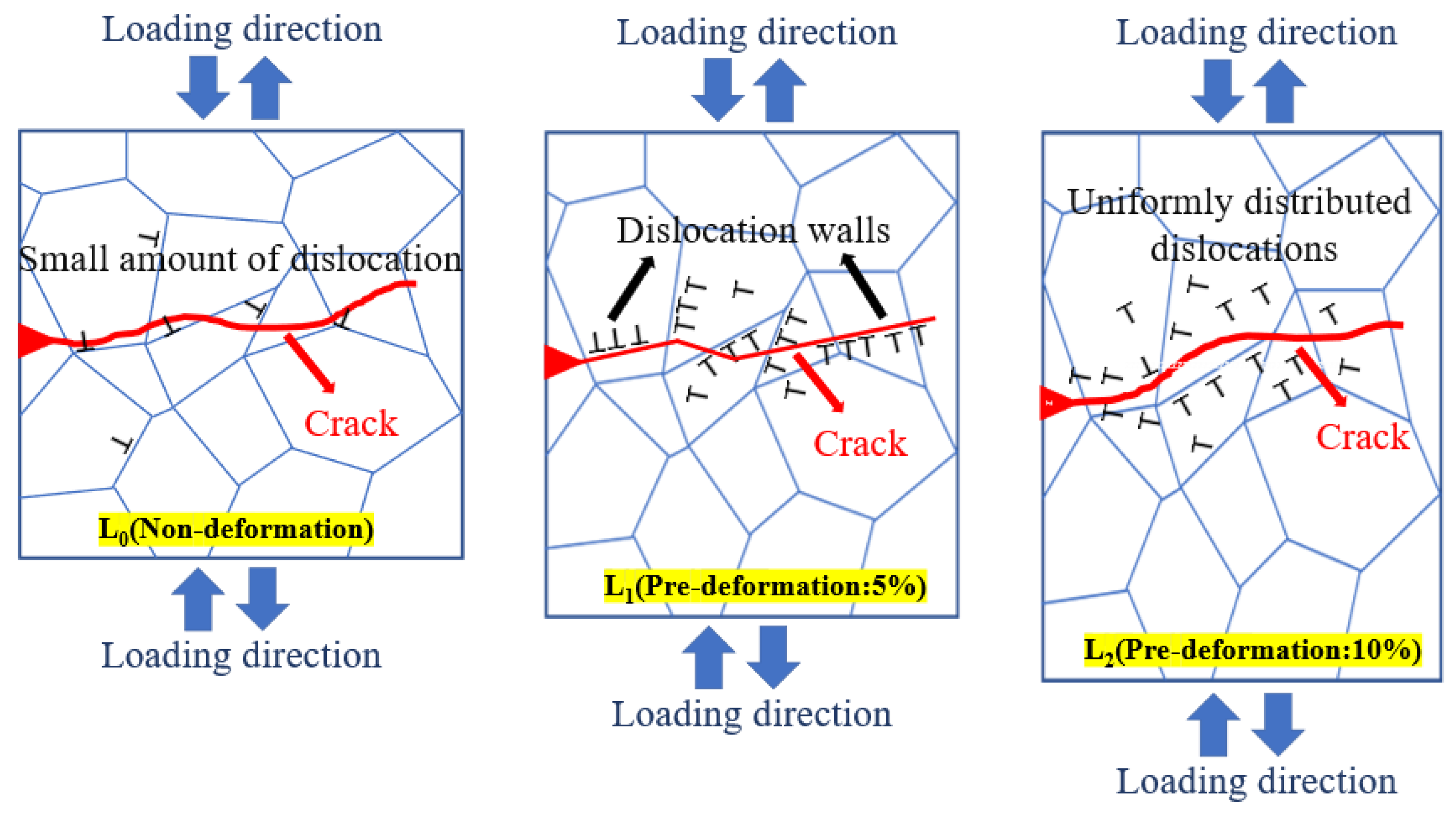
| Material | Zn | Mg | Cu | Mn | Si | Ti | Cr | Fe | Al |
|---|---|---|---|---|---|---|---|---|---|
| Al-Mg-Zn alloy | 4.0~5.0 | 1.0~1.8 | 0.10 | 0.20~0.70 | 0.35 | 0.01~0.06 | 0.06~0.20 | 0.40 | Bal. |
| Degree of Pre-Deformation | Constant C | Constant m | Paris Formula |
|---|---|---|---|
| L0 (non-deformation) | 7.09 × 10−8 | 5.43 | da/dN = 7.09 × 10−8(ΔK)5.43 |
| L1 (5% pre-deformation) | 2.66 × 10−8 | 5.23 | da/dN = 2.66 × 10−8(ΔK)5.23 |
| L2 (10% pre-deformation) | 8.41 × 10−10 | 7.11 | da/dN = 8.41 × 10−10(ΔK)7.11 |
Disclaimer/Publisher’s Note: The statements, opinions and data contained in all publications are solely those of the individual author(s) and contributor(s) and not of MDPI and/or the editor(s). MDPI and/or the editor(s) disclaim responsibility for any injury to people or property resulting from any ideas, methods, instructions or products referred to in the content. |
© 2025 by the authors. Licensee MDPI, Basel, Switzerland. This article is an open access article distributed under the terms and conditions of the Creative Commons Attribution (CC BY) license (https://creativecommons.org/licenses/by/4.0/).
Share and Cite
Jiang, H.; Jin, J.; Fang, Y.; Gou, G.; Lu, W.; Zhang, Z.; Zhou, H.; Sun, H.; Feng, J.; Chen, J.; et al. Effects of Pre-Deformation in Corrosion Fatigue Crack Growth of Al-Mg-Zn Alloy. Materials 2025, 18, 365. https://doi.org/10.3390/ma18020365
Jiang H, Jin J, Fang Y, Gou G, Lu W, Zhang Z, Zhou H, Sun H, Feng J, Chen J, et al. Effects of Pre-Deformation in Corrosion Fatigue Crack Growth of Al-Mg-Zn Alloy. Materials. 2025; 18(2):365. https://doi.org/10.3390/ma18020365
Chicago/Turabian StyleJiang, Hui, Junjun Jin, Yu Fang, Guoqing Gou, Wei Lu, Zhiyi Zhang, Hongmei Zhou, Hairong Sun, Jikui Feng, Jia Chen, and et al. 2025. "Effects of Pre-Deformation in Corrosion Fatigue Crack Growth of Al-Mg-Zn Alloy" Materials 18, no. 2: 365. https://doi.org/10.3390/ma18020365
APA StyleJiang, H., Jin, J., Fang, Y., Gou, G., Lu, W., Zhang, Z., Zhou, H., Sun, H., Feng, J., Chen, J., & Fu, Z. (2025). Effects of Pre-Deformation in Corrosion Fatigue Crack Growth of Al-Mg-Zn Alloy. Materials, 18(2), 365. https://doi.org/10.3390/ma18020365






